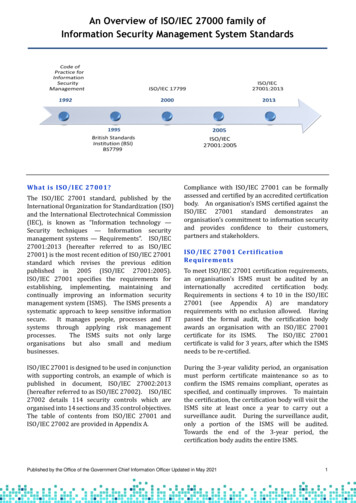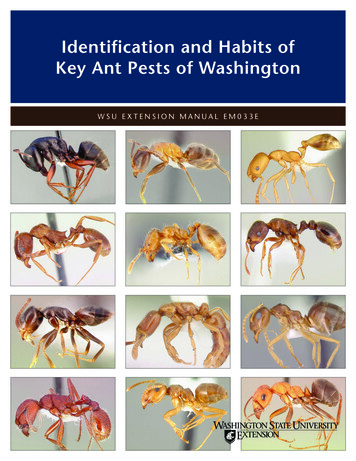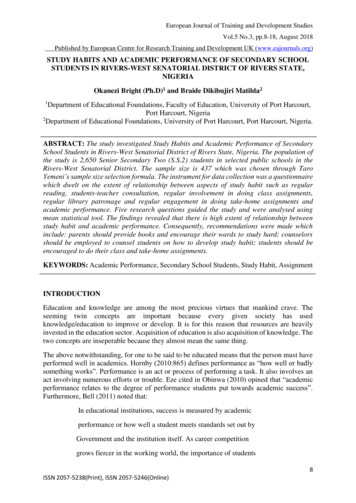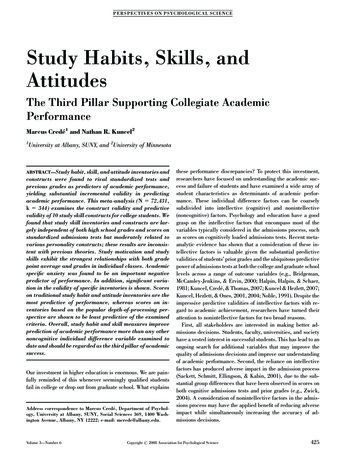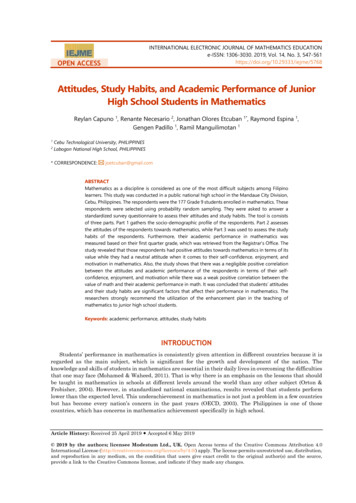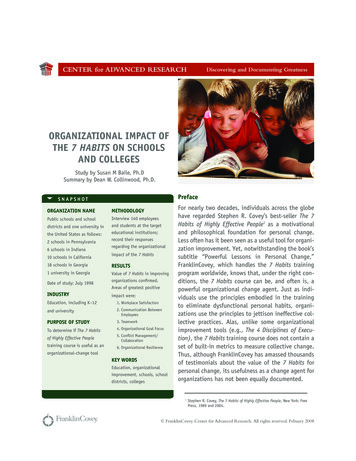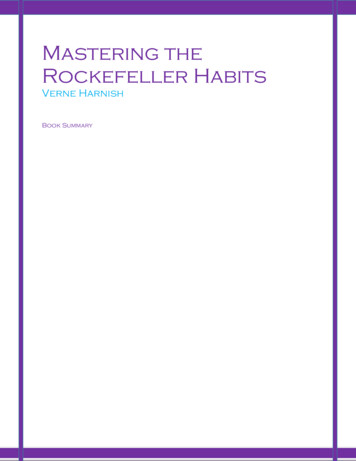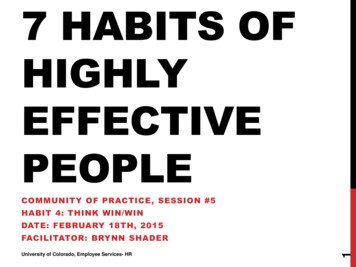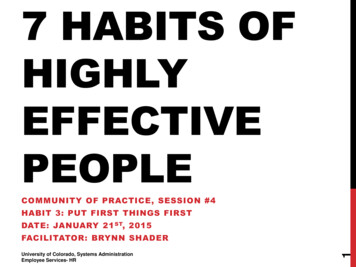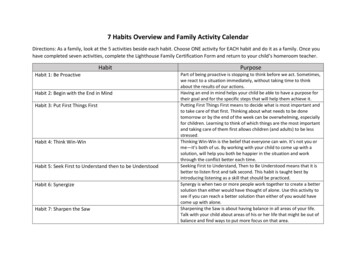
Transcription
7 Habits Overview and Family Activity CalendarDirections: As a family, look at the 5 activities beside each habit. Choose ONE activity for EACH habit and do it as a family. Once youhave completed seven activities, complete the Lighthouse Family Certification Form and return to your child’s homeroom teacher.HabitHabit 1: Be ProactiveHabit 2: Begin with the End in MindHabit 3: Put First Things FirstHabit 4: Think Win-WinHabit 5: Seek First to Understand then to be UnderstoodHabit 6: SynergizeHabit 7: Sharpen the SawPurposePart of being proactive is stopping to think before we act. Sometimes,we react to a situation immediately, without taking time to thinkabout the results of our actions.Having an end in mind helps your child be able to have a purpose fortheir goal and for the specific steps that will help them achieve it.Putting First Things First means to decide what is most important andto take care of that first. Thinking about what needs to be donetomorrow or by the end of the week can be overwhelming, especiallyfor children. Learning to think of which things are the most importantand taking care of them first allows children (and adults) to be lessstressed.Thinking Win-Win is the belief that everyone can win. It’s not you orme—it’s both of us. By working with your child to come up with asolution, will help you both be happier in the situation and workthrough the conflict better each time.Seeking First to Understand, Then to Be Understood means that it isbetter to listen first and talk second. This habit is taught best byintroducing listening as a skill that should be practiced.Synergy is when two or more people work together to create a bettersolution than either would have thought of alone. Use this activity tosee if you can reach a better solution than either of you would havecome up with alone.Sharpening the Saw is about having balance in all areas of your life.Talk with your child about areas of his or her life that might be out ofbalance and find ways to put more focus on that area.
HABITHabit #1Be ProactiveACTIVITY #1As a family write apoem about beingProactive.ACTIVITY #2Everyone in thefamily packs lunchesand lays out theirclothes the nightbefore school.Habit #2Begin with the Endin MindSet 2 goals as a familyand create a timelinefor reaching the goals.Create a menu as afamily for a dinnerthen follow and cookthe meal as a family.Habit #3Put First Things FirstAs a family, plan theweek or month, andwrite the plan on acalendar.As a family, writedown your big rocksas far as chores andwho is responsiblefor them. Thenassign and follow thechore list.ACTIVITY #3Decide as a family toadopt and use theProactive Languagelist below and use itas a family.ACTIVITY #4Role-play differentsituations with yourchild that will providethem the opportunityto think before theyactPlan a short trip as aAs a family (or withfamily and make a list an individual child),of the things you willchoose an area thatneed for the trip.needs improvement.The area ofimprovement, or thebroad goal, becomesyour end in mind.Then think of specificsteps that will lead toachieving this goal.As a family,As a family, clean andbrainstorm thingsorganize one room inthat might wastethe house thattime and look to seeeveryone uses, thenif they get in the waycelebrate!of other things thatneed to becompleted. Make alist of the timewasters to see howthey can be changed.ACTIVITY #5Create your ownfamily missionstatement and post itsomewhere in thehouse.Kids in the family willwrite a short storyabout: When I GrowUp I Want to Be Work together as afamily to complete alarge task at somesuch as cleaning thegarage or yard andcelebrate as a familywith a movie andpopcorn!
HABITHabit #4Think Win-WinACTIVITY #1Play a board game as afamily. After someonewins, explain howcompetition is okaywhen you play a game,but it’s not okay inpersonal relationships.ACTIVITY #2As a family create anemotional bankaccount bucket andkeep a packet ofnotes near thebucket. At the end ofeach week read thedeposits as a familyduring dinner.Habit #5Seek First toUnderstand then tobe UnderstoodPlay the charade gamewith your family. Eachmember has to act outan emotion withoutwords and the familymembers have toguess. Split the familyinto teams and theteam with the mostcorrect guesses wins.Check out the book,“The 7 Habits ofHappy Kids” book.Read the story,“Jumper and the LostButterfly Net: andanswer the Up forDiscussion questionson pp. 65.ACTIVITY #3As a family, create a“Caught ThinkingWin-Win Chart” andpost it on therefrigerator. Ifsomeone is “caught”they get to writetheir name on thechart to berecognized by thefamily at acelebration.As a family, discusssomeone you allknow that is a goodlistener. As a group,list the qualities thatperson has thatmakes them a goodlistener.ACTIVITY #4Play the gameTic-Tac-Treat as afamily and discussafter the game, theidea of an abundancemindset.(See the gamebelow)ACTIVITY #5As a family sharingactivity, each familymember will share astory about a conflictand then discuss howthey resolved theconflict. The familywill write down theresolutions and usethem to solve futureconflicts.As a family, play thetelephone game.Someone tells thefirst person a shortstory, they relay it tothe next person untilyou reach the end.Then as a familycompare stories tosee how importantlistening is to relayingfacts. Write thebeginning and finalstory down tocompare.Each family membergets a piece of paperand a pencil. Theywrite down thefollowing:A good listener has:A good listenerthinks:A good listenerlistens for:A good listener doesnot:Each memberfinishes the sentenceand then has adiscussion tocompare lists.
HABITHabit #6SynergizeACTIVITY #1With your children,choose a problem youhave like completingchores or tasks. Usethe Synergy Action Plan(below) to summarizeyour solutions as afamily.ACTIVITY #2Start a familyprogram whereeveryone drops whatthey are doing topitch in and work asa team to clean thehouse, work in theyard, wash dishes,etc. Write down howeveryone felt afterthe activity iscomplete.ACTIVITY #3As a family, everyonewill write down whatthey are good at, thenshare the lists witheachotheranddiscuss how theycould Synergize onhomework, chores,playing games, sportsetc.ACTIVITY #4As a family, writedown the qualitiesthat make a goodteam member and abad team member.Discuss thedifference in thequalities and howeveryone will committo using the qualitiesof a good teammember in thefuture.ACTIVITY #5Check out the book,“The 7 Habits ofHappy Kids” and readthe story “The BigBad Badgers.” As afamily, answer theUp for Discussionquestions on pp. 77.Habit #7Sharpen the SawAs a family, develop aSharpen the Sawactivity as a family todo arts-and-crafts,games, puzzles, read astory etc. Schedule thison the calendar.As a family, pick amenu that everyoneloves and cooktogether and enjoyeach other’s time ata meal--breakfast,lunch or dinner.Plan an outdoorpicnic and hike as afamily—enjoy thetime together andeach family memberwrite a reflection onthe day.As a family, choose avolunteer activity inthe community or atyour school and worktogether to volunteeras a family. Write afamily reflection onthe day.As a family, work onthe Baby Stepsactivity. (See below)Write a shortreflection on whichnew habit helped themost.
Proactive Language Activity“Let’s look at alternatives.”“We can choose a different approach.”“We can control our own feelings.”“We can choose an appropriate response.”We can We prefer We will
The Activity: Tick-Tack-TreatSupplies: A white or black board,pens/chalk, erasera 5 5 checkered gridmasking tape (for the grid)small wrapped candySet-up: Create the grid in advance.Ask for volunteers for a ‘challenge’.Place family members into groups of two.
The pairs sit on benches or on the floor in two rows in front of the checkered playing grid. One group isassigned X and the other O, and they are given the following instructions: (As described in The Debrief, yourlanguage here is important.Discuss the rules, “The task for one person is to get four X’s in a row, and you get a treat.” “The task for thisone person is to get four O’s in a row and you get a treat.”The pairs alternate opportunities to put a mark on the grid, and pairs will take turns so that they rotate whogets to place the mark on the grid.The Lesson: What happens when a person gets four in a row?When a person gets four in a row, they get candy BUT the game keeps going! (Do not tell them this in theset-up).What usually happens is that the first person or first few attempts turn into battling one anothercompetitively, trying to block their “opponent”. When they realize that the game continues after candy isgiven out, then eventually they realize that it is in their best interest not to compete but to work together tomaximize how much candy each person can get.The Debrief: What was the goal of the activity?It is interesting what responses you will get to this question, but what you are looking for is, “To get candy”.What happened when you got candy? (The game kept going)What did the last group figure out?Note the language in these following questions- Keep this language out of the activity to enrich the
discussion during the debrief.Did I ever say it was a competition? (No)Did I call you teams? (No)Did I call it a game? (No, a ‘challenge’, or you can say ‘activity’)Did I say that you had to put your own symbol, X or O, on the grid? (This is an interesting point- if you arecareful in your explanation then team members could have taken turns placing four X’s in a row, two fromeach group, followed by four O’s on the grid. They share in completing each other’s task.)Question students about competition and why they thought it was a game with two opposing teams (Teamsports, game shows, -competitive paradigm)Now is your opportunity to refer back to the framing story “When one eye is fixed upon your destination,there is only one eye left with which to find the Way” Sometimes we try harder instead of trying smarter.Sometimes we are so fixed on the task, (what we are doing), that we forget the goal or the outcome, (whatwe really want).The challenge itself becomes an experience to understand this leadership concept, anexperience far more meaningful than just explicitly explaining the concept. Also, even the spectators thatdon’t get to participate and ‘experience’ the challenge have a more meaningful representation of the lesson,as the challenge becomes a visual metaphor for them. (Share the candy with everyone during the debrief!)––––––––––Think Win-WinWin-Win is a belief in the Third Alternative.It’s not your way or my way; it’s a better way.A higher way.
Synergy Action Plan:1. Define the problem.2. Share your views.3. Think of solutions.4. Choose the best solution together and write the solution in the form of a plan.Baby Steps Activity:Baby Steps:1 . For two nights in a row, go to bed early and see how great you feel when you wake up!2. For one whole week, read for twenty minutes every day.3. Today go play with someone who you haven’t played with for a long time.4. Go to one of your favorite spots in nature, like a mountain, a park, or a stream. When you getthere, think about all the things in your life that make you happy, like your grandma, your dog afun toy, or playing with your friends.
7 Habits Overview and Family Activity Calendar Directions: As a family, look at the 5 activities beside each habit. Choose ONE activity for EACH habit and do it as a family. Once you have completed seven activities, complete the Lighthouse Family ertification Form and return to your child’s homeroom teacher. Habit Purpose Habit 1: Be Proactive Part of being proactive is stopping to think .
